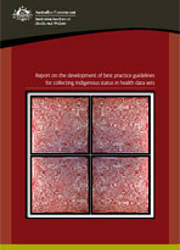National best practice guidelines for collecting Indigenous status in health data sets
Citation
AIHW
Australian Institute of Health and Welfare (2010) National best practice guidelines for collecting Indigenous status in health data sets, AIHW, Australian Government, accessed 25 April 2024.
APA
Australian Institute of Health and Welfare. (2010). National best practice guidelines for collecting Indigenous status in health data sets. Canberra: AIHW.
MLA
Australian Institute of Health and Welfare. National best practice guidelines for collecting Indigenous status in health data sets. AIHW, 2010.
Vancouver
Australian Institute of Health and Welfare. National best practice guidelines for collecting Indigenous status in health data sets. Canberra: AIHW; 2010.
Harvard
Australian Institute of Health and Welfare 2010, National best practice guidelines for collecting Indigenous status in health data sets, AIHW, Canberra.
PDF | 592Kb
All clients of health services should be asked if they are of Aboriginal and/or Torres Strait Islander origin in the process of routine data collection. Despite improvements in recent years, there have been continuing problems in establishing and maintaining standard practice in the collection of Indigenous status, resulting in the under-identification of Aboriginal and Torres Strait Islander people in key national health data sets. These guidelines have been developed to ensure the standard Indigenous status question is asked correctly and consistently of all clients of health services, and that this information is correctly recorded. Limit of 5 copies.
- ISBN: 978 1 74024 998 0
- Cat. no: IHW 29
- Pages: 32
-
The Best Practice Guidelines document the recommended national approach to collect and record Indigenous status
-
A systematic national approach is needed to ensure the Indigenous status question is asked correctly, consistently
-
Promote the Guidelines widely to ensure their routine use across various service provision settings and client groups
-
NIDISC provides support to jurisdictions and service providers to implement the guidelines



